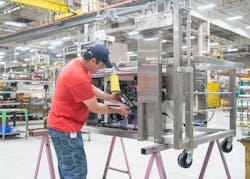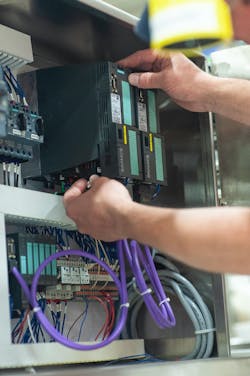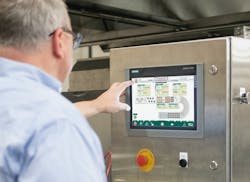Doughnuts are, obviously, the first thing that comes to mind when you hear the name Krispy Kreme. But for those with an interest in automation and manufacturing, you’re missing a big part of the Krispy Kreme story if you’re not familiar with the company’s machine building operations.
This aspect of Krispy Kreme’s operations is nothing new, as the company has designed and built proprietary machines from the company’s early days. Today, the company’s headquarters in Winston Salem, N.C., is home to a 105,000-sq.-ft. manufacturing facility that houses research, design, testing, engineering, and production operations.
“They engineer and manufacture all of their production machines, from extruders and conveyors through to the packaging, including their famous glaze waterfall,” says Bobby Cole, president of Think PLC.
Cole says the speed at which an extruded doughnut moves through the store is “a very, very big deal. Throughout the process, the shortening is kept within an exact range of temperature. Doughnuts are cooked on both sides for a precise number of seconds on each side and the cooling conveyor cycles through the store at a set number of minutes.”
Updating via retrofit
Recently, Krispy Kreme has been updating its manufacturing operations based on insights from the company’s service technicians, store managers, and customers. Patrick Betson, Krispy Kreme’s director of equipment manufacturing, says this feedback has led to several improvements addressing increased uptime and mean time before failure.
“Before there was much publicity about Industry 4.0 and IoT (Internet of Things), Bobby Cole and I often talked about the data that could be generated by more advanced machine monitoring,” says Betson. “It became increasingly clear that by integrating the latest Siemens drives and controls on our machines, and connecting them using Profinet communications, we could start putting that data to work.”
To enable consistent automation upgrades and retrofitting at existing stores and plan for the roll out of equipment at new stores, Think PLC needed to determine the fastest and most cost-efficient way to integrate Siemens Sinamics G120 variable frequency drive (VFD) technology in more than 600 stores worldwide.
This led Betson and Cole to develop a retrofit kit that would allow every store to quickly add new components and software to their existing hardware.
The key to Think PLC’s retrofit idea was to leverage the SD cards used on Siemens drives and controls already in Krispy Kreme stores. The was a viable approach because Krispy Kreme maintained each store’s unique set of machining and processing parameters on the SD cards. As a result, stores only need a local contractor to upgrade the legacy control panels, including parts for safety and power wiring.
According to Cole, the retrofit kit enables a store to replace its drives and controls in about two hours—saving significant time and costs associated with having a control technician travel to a Krispy Kreme store to perform the work.
To prove the retrofit kit concept, Krispy Kreme and Think PLC tested the kit’s installation and use in their manufacturing plant in Winston-Salem, N.C., followed by tests at various stores in the region. During these tests, the new drives and PLCs installed smoothly and the SD cards automatically updated and matched all previous store parameters. To further test the concept, Cole and Betson retrofitted every Krispy Kreme store (more than 30) in Australia in five days using the kits.
Fry control
During the doughnut frying process, the pumping of heated shortening is critical to maintaining optimal doughnut quality and product count. When the flow rate is not maintained at the desired constant, viscosity issues become a problem as dough bits cannot be filtered out of the melted shortening properly. This leads to temperature variances, causing hot spots to develop.
The Sinamics G120 drive addresses these pump motor issues while reporting the operational status of each motor. The drive also ensures that pump motor temperatures are kept below the threshold for heat damage.
Cole explains the drive can address pump motor issues through its ability to set and hold a curve that assures the most efficient flow at a low speed and a high speed—from 7 hertz to 90 hertz. With the new drives, “accuracy of the fry time has increased by 12%, resulting in a more consistent product with less waste yield,” he says. “A big advantage of the drive is that it can run a motor slow without the usual rise in motor temp. When you run a motor at very low hertz, it generates a lot of eddy current. It gets so hot, that you can’t touch the motor. And when you overheat the laminations of a motor, you greatly decrease the life of the motor. But we can monitor each drive through the Siemens TIA (Totally Integrated Automation) portal, and we’ve seen the amperage reduced by almost 17%, and the temperature of the motor reduced by 34%. We expect this will more than double the life expectancy of every pump.”
The Sinamics G120 drives also address worker safety issues through their triple-quadruple redundancy, says Cole. “The new drives and PLCs being retrofitted into every store integrate with the existing Siemens safety monitoring circuitry, including the automated safety mechanisms and E-stop buttons. For example, if a hose were to break on the shortening pump, the flow stops within 100 milliseconds,” he says.
Remote access via TIA
Using Siemens TIA portal, Think PLC can access any of the Siemens G-120 drives remotely.
Cole describes using the TIA portal via his smartphone as being like standing in a Krispy Kreme store at the drive’s operator interface.
About the Author
David Greenfield, editor in chief
Editor in Chief

Leaders relevant to this article:



